List of Ethiopian dishes and foods
This is a list of Ethiopian dishes and foods. Ethiopian cuisine characteristically consists of vegetable and often very spicy meat dishes, usually in the form of wat (also w'et or wot), a thick stew, served atop injera, a large sourdough flatbread,[1] which is about 50 centimeters (20 inches) in diameter and made out of fermented teff flour.[1] Ethiopians eat exclusively with their right hands, using pieces of injera to pick up bites of entrées and side dishes.[1] Utensils are rarely used with Ethiopian cuisine.
Ethiopian dishes and foods
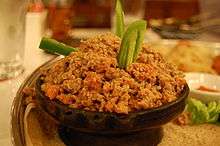
Kitfo is a traditional dish in Ethiopian cuisine
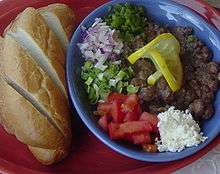
Shahan ful (pictured right, garnished with lemon)
- Ensete – An economically important food crop in Ethiopia.[2][3]
- Teff – a grain widely cultivated and used in the countries of Eritrea and Ethiopia, where it is used to make injera or tayta. Teff accounts for about a quarter of total cereal production in Ethiopia.[4]
- Fit-fit – an Ethiopian and Eritrean food typically served for breakfast
- Ful medames – an Egyptian dish of cooked and mashed fava beans served with vegetable oil, cumin and optionally with chopped parsley, onion, garlic, and lemon juice, it is also a popular meal in Ethiopia and other countries
- Genfo – a stiff porridge
- Gored gored – a raw beef dish
- Guizotia abyssinica – an erect, stout, branched annual herb, grown for its edible oil and seed
- Himbasha
- Injera – a spongy, slightly sour flatbread regularly served with other dishes
- Kittaa
- Kitfo
- Niter kibbeh – a seasoned, clarified butter used in Ethiopian cooking
- Rhamnus prinoides
- Samosa (also sambusa)
- Shahan ful
- Shiro – a stew with primary ingredients of powdered chickpeas or broad bean meal
- Wat – stew or curry that may be prepared with chicken, beef, lamb, a variety of vegetables, spice mixtures such as berbere, and niter kibbeh, a seasoned clarified butter. Wat is traditionally eaten with injera.
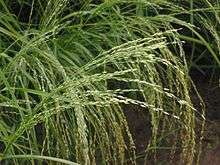
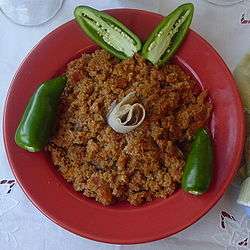
 Ful medames served with sliced hard-boiled eggs
Ful medames served with sliced hard-boiled eggs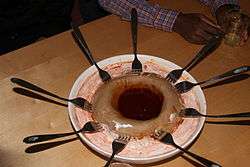
Spices
- Aframomum corrorima – The spice known as korarima, Ethiopian cardamom, or false cardamom[5] is obtained from the plant's seeds (usually dried), and is extensively used in Ethiopian and Eritrean cuisine. It is an ingredient in berbere, mitmita, awaze, and other spice mixtures, and is also used to flavor coffee.[6]
- Berbere – usually include chili peppers, garlic, ginger, basil, korarima, rue, ajwain or radhuni, nigella, and fenugreek.[7][8][9]
- Mitmita – a powdered seasoning mix used in Ethiopian and Eritrean cuisine
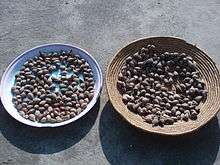 Dried korarima fruits from Aframomum corrorima, in preparation for making berbere
Dried korarima fruits from Aframomum corrorima, in preparation for making berbere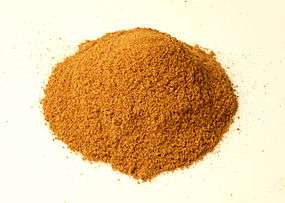
Beverages
See also: Coffee production in Ethiopia and Jebena
- Coffee
- Tej – a honey wine[10] or mead that is brewed and consumed in Ethiopia and Eritrea
- Tella – a traditional beer from Ethiopia and Eritrea
.jpg) Ethiopian tej
Ethiopian tej
See also
References
- 1 2 3 Javins, Marie. "Eating and Drinking in Ethiopia." Gonomad.com. Accessed July 2011.
- ↑ RHS A-Z encyclopedia of garden plants. United Kingdom: Dorling Kindersley. 2008. p. 1136. ISBN 1405332964.
- ↑ "Uses of Enset". The 'Tree Against Hunger': Enset-Based Agricultural Systems in Ethiopia. American Association for the Advancement of Science. 1997. Retrieved 13 August 2007.
- ↑ Gabre-Madhin, Eleni Zaude. Market Institutions, Transaction Costs, and Social Capital in the Ethiopian Grain Market. Washington, DC: International Food Policy Research Institute, 2001
- ↑ Aframomum corrorima was published in Spices, Condiments and Medicinal Plants in Ethiopia, Their Taxonomy and Agricultural Significance. (Agric. Res. Rep. 906 & Belmontia New Series) 12:10. 1981. The specific epithet was taken from its basionym, Amomum corrorima A.Braun GRIN (April 9, 2011). "Aframomum corrorima information from NPGS/GRIN". Taxonomy for Plants. National Germplasm Resources Laboratory, Beltsville, Maryland: USDA, ARS, National Genetic Resources Program. Retrieved June 19, 2011.
Synonyms: (≡) Amomum corrorima A.Braun (basionym)
- ↑ Bernard Roussel & François Verdeaux (April 6–10, 2003). "Natural patrimony and local communities in ethiopia: geographical advantages and limitations of a system of indications" (PDF). 29th Annual Spring Symposium of Centre for African Studies. Archived from the original (PDF) on 2006-11-26.
This Zingiberaceae, Aframomum corrorima (Braun) Jansen, is gathered in forests, and also grown in gardens. It is a basic spice in Ethiopia, used to flavor coffee and as an ingredient in various widely used condiments (berbere, mitmita, awaze, among others).
- ↑ Debrawork Abate (1995(EC)) [1993(EC)]. የባህላዌ መግቦች አዘገጃጀት [Traditional Food Preparation] (in Amharic) (2nd ed.). Addis Ababa: Mega Asatame Derjet (Mega Publisher Enterprise). pp. 22–23. Check date values in:
|date=(help) - ↑ Gall, Alevtina; Zerihun Shenkute (November 3, 2009). "Ethiopian Traditional and Herbal Medications and their Interactions with Conventional Drugs". EthnoMed. University of Washington. Retrieved January 27, 2011.
- ↑ Katzer, Gernot (July 20, 2010). "Ajwain (Trachyspermum copticum [L.] Link)". Retrieved January 28, 2013.
- ↑ Bahiru, Bekele; (et al.) (July–September 2001). "Chemical and nutritional properties of 'tej', an indigenous Ethiopian honey wine: variations within and between production units". Vol. 6, No. 3. The Journal of Food Technology in Africa. pp. 104–108. Retrieved 13 November 2014.
| Wikimedia Commons has media related to Cuisine of Ethiopia. |
This article is issued from Wikipedia - version of the 10/25/2016. The text is available under the Creative Commons Attribution/Share Alike but additional terms may apply for the media files.